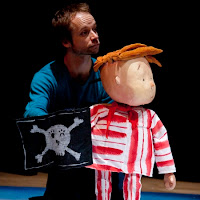KIM: It says in marketing pack for The Night Pirates that you have kept the performance close to the book, whilst making the most of the theatrical environment. What interested you about the book?
MIRANDA: I was interested in the ‘kidology’ of the book which appeals equally to both genders. From an adult perspective, the story seems daft (i.e. adults always get hung up on the subsidence of the house etc!) but for children, the adventure has real resonance. They empathise with Tom’s fear and then delight at the idea of a night time adventure, they love the ‘twist’ that the pirates are girls, they are thrilled when they overcome the grown-ups and, at the end of the night, Tom returns safely to bed. It also has many extension opportunities – pirates are such a part of this age groups imaginative landscape – and lots of fun for us too.
KIM: How important is it to balance the textual and visual elements of the book and how did you do this? What issues arose in the adaptation process and how did you overcome them?
MIRANDA: The adaptation has been challenging – the visual language of the book is so strong that we have had to make a very clear decision to embrace that and try and replicate it on stage. The designer has found it particularly frustrating because her job is usually to find a visual language and here she has had to adapt and problem solve. Also, there is very little ‘drama’ in the book, it is very ‘thin’ for the stage, but again we have embraced that and, using only the text as written, found models of theatrical, musical and dance storytelling to fill those gaps and make the piece fuller as a theatrical experience.
KIM: Do you feel that the performance has added anything to the experience of reading the book?
MIRANDA: We hope that the world of Tom and his night time adventures will become even more enthralling and engaging for the children in terms of enhancing their experience of the story – whether we achieve that will be down to the audiences of kids who we preview to.
KIM: The Night Pirates has some interesting stylistic aspects, in terms of text and structure on the page, did you choose to translate this theatrically? If so, how?
MIRANDA: The structure of the language on the page led us to a dance interpretation because the arrows indicated dance notation and movement journeys.
KIM: Theatre Hullabaloo stages both adaptations and devised or original work so there is obviously a balance in your company between the two. Why choose to adapt and what are the advantages and disadvantages of doing so? What is the role of adaptation, and those of picturebooks in particular, in your company and the wider context of theatre for children? Does their success hinder opportunities to create original work or can they open doors to new possibilities?
MIRANDA: The clearest advantage of adaptation, particularly of a book as popular as The Night Pirates, is the way it generates box office. Venues are very keen to book and we are doing remarkably well in terms of ticket sales. My reservation about adaptations is that I think they can sometimes be theatrically lazy as the children know the story and the characters and so the Creative Team is engaged with giving them a theatrical identity rather than being able to create a new world. I think that is why we have chosen such a departure in our use of ballet as a central part of the storytelling, so we are sure that we are creating a very vivid new experience for our audiences.
For a company such as Theatre Hullabaloo, I think an adaptation in amongst new work helps to support the company’s repertoire, but I would not want us to just produce adaptations – we want children to understand that the theatre is a place where original worlds and stories can come to life rather than somewhere that simply dramatises known worlds and characters.
KIM: Is it important for children to see and experience theatre? Do works for children have to be educational or do you think there is more of a focus on cultural learning? The book is not overtly educational and yet the themes, such as bravery, are very relevant (the section of your marketing document on how to sell for schools is really useful). How are these themes presented theatrically and do you feel that the experience of theatre is just as important as the educational focus?
MIRANDA: It is crucially important that children have opportunities to experience theatre that is created for them and with proper investment, high production values and artists of the highest calibre. Why? For the same reasons that any of us ‘need’ theatre, or for that matter, art – it helps us to view the world and our place in it in a different way, to value a ‘live’ experience shared with others, to appreciate that magic can be created through ideas rather than just CGI. Too often children’s theatre is ‘dumbed down’, low quality, cheap laughs or overtly didactic – none of these things make for good art and we send a dangerous message to young audiences about the quality of experience that they should expect from the arts if we don’t challenge this. There is a place for education in art, but it’s a much more sophisticated position than the ‘play about drugs’, its about creating safe spaces for us to imagine and learn and about convincing the grown-ups that these are important things to nurture and protect.









No comments:
Post a Comment